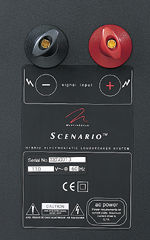MartinLogan Prodigy Speaker System Page 2
 According to "statophiles," the sound of music is spectacularly in-phase and lifelike because there is no driver interaction to contend with. On the downside (nothing's perfect, eh?), electrostats have traditionally had problems with dispersion and production of low frequencies. Because of the large size of the diaphragm relative to the small wavelength of high frequencies, dispersion of sound—especially in the high-frequency range—can be quite directional or narrow (think dinky sweet spot). On the low-bass side, simply put, little if any existed.
According to "statophiles," the sound of music is spectacularly in-phase and lifelike because there is no driver interaction to contend with. On the downside (nothing's perfect, eh?), electrostats have traditionally had problems with dispersion and production of low frequencies. Because of the large size of the diaphragm relative to the small wavelength of high frequencies, dispersion of sound—especially in the high-frequency range—can be quite directional or narrow (think dinky sweet spot). On the low-bass side, simply put, little if any existed.
Clearly, both characteristics limit the use of 'stats for home theater applications. That is, until now, according to MartinLogan. Over the last decade, ML has gone where few others have tread, throwing great resources into building hybrid electrostatic speakers. A unique marriage of both diaphragm and bass-cone technologies, the MartinLogan hybrid setup under review is said to eliminate the shortcomings of classic electrostatics, creating what ML calls a "new world of home theater."
Fairly large (16.5 inches wide by 28 deep by 67 high), each Prodigy comes in two sections: the bass module and the electrostatic panel, which couple readily into a 133-pound back-wrenching unit. To minimize dispersion problems common to most 'stats, ML has come up with an ingenious solution. Instead of a standard rectangular configuration, the entire electrostatic panel is curved, creating what ML calls the Curvilinear Line Source (CLS). Incidentally, ML's diaphragm, made of ultrathin polyester, is sandwiched between perforated, thin steel stators. Additionally, between each diaphragm and stator, you'll find narrow spacers that damp the stators while providing an air gap in which the diaphragm can move. CLS is said to generate a controlled 30-degree cylindrical wave front from each channel, leading to a broad listening area with precise image capabilities.
 The bass module—a sealed-box, dual-woofer design—consists of two 10-inch drivers, with an aluminum cone and a high-rigidity fiber cone in a configuration ML calls ForceForward technology. Essentially, the forward driver loads the room, while proprietary phase-alignment techniques eliminate the rear-firing low-frequency sound energy. ForceForward is said to allow easier placement of the speakers, delivering clean bass down to 28 Hz without excessive worry about the reflected bass wave arriving after the initial transient has been launched toward the listening position(s). Additionally, a switch on the rear of the bass module allows a choice between flat response (0 decibels) or a boost (+3 dB) in the 50-Hz region to compensate for weak in-room response. The crossover frequency into the diaphragm is shown as 250 Hz, well below the start of the "critical zone." Also, MartinLogan points out that amps in the 80- to 100-watt range have successfully driven the Prodigies; however, to obtain the best possible performance, workhorse amplifiers pushing in excess of 250 wpc, like ATI's AT2505, made the MLs sing. Additionally, these speakers play best when biwired.
The bass module—a sealed-box, dual-woofer design—consists of two 10-inch drivers, with an aluminum cone and a high-rigidity fiber cone in a configuration ML calls ForceForward technology. Essentially, the forward driver loads the room, while proprietary phase-alignment techniques eliminate the rear-firing low-frequency sound energy. ForceForward is said to allow easier placement of the speakers, delivering clean bass down to 28 Hz without excessive worry about the reflected bass wave arriving after the initial transient has been launched toward the listening position(s). Additionally, a switch on the rear of the bass module allows a choice between flat response (0 decibels) or a boost (+3 dB) in the 50-Hz region to compensate for weak in-room response. The crossover frequency into the diaphragm is shown as 250 Hz, well below the start of the "critical zone." Also, MartinLogan points out that amps in the 80- to 100-watt range have successfully driven the Prodigies; however, to obtain the best possible performance, workhorse amplifiers pushing in excess of 250 wpc, like ATI's AT2505, made the MLs sing. Additionally, these speakers play best when biwired.
Did I mention that this is one beautiful-looking speaker? The see-through diaphragm and wood-panel siding (assorted options are available) make an impressively modern statement. Despite the ForceForward technology, the Prodigies require some experimentation before optimal position can be obtained, although there is greater latitude with these than most other 'stats.
Another unique hybrid design, the Theater is a three-way configuration, employing a convex electrostatic panel like the Prodigy for the midrange, plus three 1-inch soft-dome tweeters for frequencies above 3.5 kHz and two 6.5-inch cone woofers. The centered tweeters, arranged in a controlled-dispersion array, flawlessly localize onscreen dialogue and control the dispersion to more closely match the dispersion of the ESL element. This allows the all-important midrange to be handled strictly by the diaphragm, while the two asymmetrically arranged larger drivers (they are symmetrically arranged relative to each other but are asymmetrical in relation to the cabinet) on the edges of the Theater cover 70 Hz to 300 Hz. All three drivers are voiced to match the diaphragm.





























































